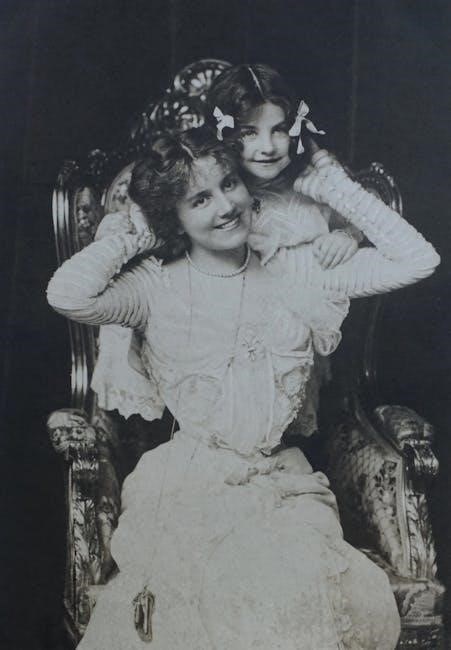
memory strategies pdf
Memory strategies are techniques to enhance information retention and recall‚ helping individuals manage and improve their cognitive functions. These methods‚ such as chunking or mnemonics‚ organize data effectively‚ making it easier to remember. By understanding how memory works‚ individuals can apply these strategies to boost learning and daily tasks‚ especially for those with memory impairments.

1.1 Understanding the Importance of Memory Strategies
Memory strategies are essential for improving cognitive function and enhancing daily life. They help individuals organize information‚ making it easier to retain and recall. By using techniques like chunking or mnemonics‚ people can better manage memory challenges. These strategies are particularly vital for those with impairments‚ aiding in independence and confidence. Understanding their importance allows individuals to leverage these tools effectively‚ improving learning‚ work‚ and overall quality of life. Effective memory strategies empower the brain to function more efficiently‚ ensuring better retention and recall in various situations.
1.2 Overview of Memory Types and Functions
Memory is categorized into types‚ each serving distinct functions. Sensory memory briefly holds sensory data‚ while short-term memory retains information for immediate use. Working memory processes and manipulates information temporarily. Long-term memory stores data indefinitely‚ divided into implicit (unconscious skills) and explicit (conscious knowledge). Understanding these types helps in applying strategies effectively. Memory functions include encoding‚ storage‚ and retrieval. By recognizing how each type operates‚ individuals can employ tailored techniques to enhance retention and recall‚ optimizing cognitive performance in various tasks and daily activities.

Key Memory Strategies
Key memory strategies include chunking‚ mnemonics‚ repetition‚ and visualization. These techniques help organize and retain information effectively‚ enhancing recall and cognitive performance in various tasks.
2.1 Chunking: Breaking Down Information
Chunking involves breaking down complex information into smaller‚ manageable parts. This strategy reduces cognitive overload by organizing data into groups‚ making it easier to process and retain. For example‚ phone numbers are chunked into segments for better recall. By dividing information into meaningful units‚ individuals can enhance memory retention and retrieval. This method is particularly effective for lists‚ sequences‚ or large datasets‚ as it transforms overwhelming details into digestible pieces. Regular use of chunking improves cognitive efficiency and supports long-term memory consolidation.
2.2 Mnemonics: Using Associations and Acronyms
Mnemonics are powerful tools that use associations‚ acronyms‚ or rhymes to aid memory retention. By creating mental connections‚ mnemonics simplify complex information‚ making it easier to recall. For example‚ acronyms like “PEMDAS” (Parentheses‚ Exponents‚ Multiplication‚ Division‚ Addition‚ Subtraction) help remember mathematical operations. Rhymes‚ such as “30 days hath September‚” assist with remembering facts. These techniques reduce cognitive load and enhance long-term memory storage. Mnemonics are especially useful for memorizing sequences‚ lists‚ or abstract concepts‚ providing a structured framework for better information retrieval and application in various learning and real-life scenarios.
2.3 Repetition: Reinforcing Memory Through Practice
Repetition is a fundamental memory strategy that strengthens recall by reinforcing information through consistent practice. By revisiting material multiple times‚ especially with spaced intervals‚ the brain solidifies neural pathways‚ making information easier to retrieve. This method is particularly effective for memorizing facts‚ formulas‚ or sequences. Active recall‚ a form of repetition‚ involves self-testing without notes‚ enhancing long-term retention. Regular practice prevents the “forgetting curve” and ensures information moves from short-term to long-term memory. Consistent repetition builds confidence and improves cognitive efficiency‚ making it a cornerstone of effective learning and memory enhancement strategies.
2.4 Visualization: Enhancing Recall with Images
Visualization is a powerful memory strategy that involves creating mental images to enhance recall. By associating information with vivid pictures‚ individuals can transform abstract concepts into concrete‚ memorable forms. This technique leverages the brain’s ability to process visual information more efficiently than text or speech. Techniques like mind maps‚ image associations‚ and pictorial mnemonics help organize information into patterns‚ making it easier to retrieve. Visualization also boosts long-term memory encoding‚ as images often stick in the mind longer than words. Regular practice with this method can significantly improve retention and recall in both academic and everyday settings.

Practical Tools for Memory Enhancement
Practical tools like writing down information‚ using calendars‚ and implementing technology-based reminders offer effective ways to support memory. These aids help compensate for memory gaps and improve daily functioning by organizing tasks and reducing cognitive overload‚ making them invaluable for individuals seeking to enhance their memory capabilities effectively.
3.1 Writing It Down: External Memory Aids
Writing down information is a simple yet effective external memory aid. By recording key details‚ individuals can reduce cognitive overload and ensure important data is not forgotten. Tools like sticky notes‚ journals‚ or digital apps provide accessible ways to store information externally. Organizing written notes in a systematic manner‚ such as using dedicated notebooks or digital folders‚ enhances retrieval. This strategy is particularly helpful for individuals with impaired memory‚ as it serves as a reliable backup for mental recall. Regularly reviewing written notes can also reinforce memory and improve long-term retention.
3.2 Using Calendars and Reminders
Calendars and reminders are powerful tools for managing memory challenges. By scheduling appointments‚ tasks‚ and events‚ individuals can stay organized and reduce forgetfulness. Digital calendars on smartphones or computers allow users to set alarms and notifications‚ ensuring important dates are not missed. Physical calendars or planners also serve as visual aids‚ providing a clear overview of commitments. Combining these tools with written notes or alerts creates a robust system for tracking responsibilities. This strategy is especially beneficial for individuals with memory impairments‚ as it minimizes reliance on mental recall and helps maintain independence in daily life.
3.3 Technology-Based Memory Assistance
Technology offers innovative solutions to support memory retention and recall. Smart devices‚ apps‚ and voice assistants enable users to set reminders‚ alarms‚ and notifications for tasks and events; Applications like memory aids or task managers provide structured platforms to organize information‚ reducing the need to rely solely on mental recall. Voice recorders and digital notes further enhance memory support by allowing quick access to stored information. These tools not only improve efficiency but also boost confidence and independence for individuals managing memory challenges‚ making them indispensable in modern memory strategies.

Advanced Techniques for Better Recall
Advanced techniques refine memory recall through organized methods. Mind palaces use spatial memory‚ chaining links information sequentially‚ and interleaving mixes topics to deepen understanding‚ enhancing retention effectively.
4.1 Mind Palaces and Spatial Memory Techniques
Mind palaces‚ or memory palaces‚ leverage spatial memory to store and retrieve information. By visualizing a familiar place‚ individuals associate items with specific locations‚ enhancing recall. This technique organizes information spatially‚ making it easier to remember. Users mentally navigate their “palace‚” retrieving details linked to each spot. Visualization and emotional connections strengthen memory links. Regular practice improves efficiency. Spatial techniques are particularly effective for lists or sequences‚ aiding in long-term retention and recall. They demonstrate how memory can be systematically trained and enhanced using imaginative‚ structured methods.
4.2 Chaining: Linking Information Together
Chaining is a memory strategy that involves linking pieces of information together in a logical sequence. By creating a mental chain‚ where each item connects to the next‚ individuals can improve recall. This method is particularly useful for remembering lists or sequences. For example‚ associating each item with a vivid image or action helps reinforce the connection. Chaining works by leveraging the brain’s ability to remember patterns and relationships. Regular practice strengthens the links‚ making it easier to retrieve information. This technique is effective for both short-term and long-term memory enhancement‚ especially in structured learning environments.
4.3 Interleaving: Mixing Up Study Materials
Interleaving is a powerful memory strategy that involves mixing different types of study materials or topics during learning sessions. By alternating between subjects‚ the brain is challenged to constantly adjust and retrieve information‚ enhancing long-term retention. This method prevents mental fatigue and keeps the mind actively engaged. Research shows that interleaving improves understanding and recall by fostering deeper connections between concepts. It also helps in developing problem-solving skills by exposing learners to varied contexts. Regular use of interleaving can significantly boost memory performance and adaptability in diverse learning environments‚ making it a valuable tool for effective study routines.

Lifestyle Factors Influencing Memory
Lifestyle factors significantly impact memory‚ with sleep‚ stress‚ and exercise playing key roles. Adequate sleep consolidates memories‚ while chronic stress impairs recall. Regular physical activity enhances cognitive function‚ supporting memory health and overall brain performance.
5.1 The Role of Sleep in Memory Consolidation
Sleep plays a vital role in memory consolidation‚ the process where short-term memories are transformed into long-term ones. During sleep‚ especially REM cycles‚ the brain processes and strengthens memory traces. Research shows that sleep deprivation impairs memory recall and learning ability. Quality sleep enhances neural connections‚ allowing information to be stored more efficiently. Lack of sleep disrupts brain waves and neurotransmitters essential for memory formation. Prioritizing adequate sleep is crucial for maintaining and improving memory functions‚ making it a cornerstone of effective memory strategies.
5.2 Reducing Stress for Improved Recall
Chronic stress negatively impacts memory by altering brain structure and function‚ particularly in the hippocampus‚ which is crucial for memory formation. High cortisol levels impair neural communication‚ reducing the ability to encode and retrieve information. Stress management techniques such as mindfulness‚ meditation‚ and deep-breathing exercises can mitigate these effects. By lowering cortisol levels‚ these practices enhance cognitive clarity and improve memory recall. Incorporating stress-reduction activities into daily routines supports overall brain health and promotes better memory performance‚ making it a key component of effective memory strategies;
5.3 Physical Exercise and Cognitive Function
Physical exercise significantly enhances cognitive function by improving blood flow to the brain‚ boosting oxygen levels‚ and stimulating neurogenesis. Regular aerobic and strength-training activities promote the growth of new neural connections‚ strengthening memory and problem-solving abilities. Exercise also reduces inflammation and oxidative stress‚ which can impair cognitive health. Studies show that active individuals perform better in memory tasks and have a lower risk of age-related cognitive decline. Incorporating physical activity into daily routines is a powerful strategy to support brain health and enhance memory capabilities‚ making it a vital component of overall cognitive well-being and memory improvement strategies.

Creating New Memories and Tracking Progress
Journaling and setting memory goals help create new memories and track progress. Writing down experiences enhances recall‚ while milestones provide a clear path to monitor improvement effectively.
6.1 Journaling to Enhance Memory
Journaling is a powerful tool for enhancing memory by actively encoding information through writing. By documenting experiences‚ thoughts‚ and tasks‚ individuals can reduce cognitive load and create a permanent record. This practice strengthens retention and recall‚ as writing engages multiple brain pathways. Journaling also helps organize information‚ making it easier to retrieve later. Regular reflection on entries can reinforce memories and identify patterns‚ improving overall cognitive function. Over time‚ journaling becomes a valuable resource for tracking progress and reflecting on personal growth‚ making it a simple yet effective memory-enhancing strategy.
6.2 Setting Memory Goals and Milestones
Setting memory goals and milestones is a structured approach to improving recall and tracking progress. By defining specific‚ achievable objectives‚ individuals can focus on enhancing their cognitive abilities. These goals should be clear and measurable‚ allowing for regular assessment of improvement. Celebrating milestones‚ no matter how small‚ reinforces motivation and encourages continued effort. Regularly reviewing and adjusting these goals ensures they remain relevant and challenging. This method not only enhances memory but also builds confidence and provides a sense of accomplishment‚ fostering long-term cognitive growth and resilience.